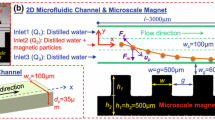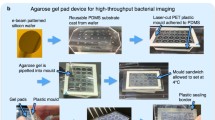Abstract
In this work a novel highly precise SU-8 fabrication technology is employed to construct microfluidic devices for sensitive dielectrophoretic (DEP) manipulation of budding yeast cells. A benchmark microfluidic live cell sorting system is presented, and the effect of microchannel misalignment above electrode topologies on live cell DEP is discussed in detail. Simplified model of budding Saccharomyces cerevisiae yeast cell is presented and validated experimentally in fabricated microfluidic devices. A novel fabrication process enabling rapid prototyping of microfluidic devices with well-aligned integrated electrodes is presented and the process flow is described. Identical devices were produced with standard soft-lithography processes. In comparison to standard PDMS based soft-lithography, an SU-8 layer was used to construct the microchannel walls sealed by a flat sheet of PDMS to obtain the microfluidic channels. Direct bonding of PDMS to SU-8 surface was achieved by efficient wet chemical silanization combined with oxygen plasma treatment of the contact surface. The presented fabrication process significantly improved the alignment of the microstructures. While, according to the benchmark study, the standard PDMS procedure fell well outside the range required for reasonable cell sorting efficiency. In addition, PDMS delamination above electrode topologies was significantly decreased over standard soft-lithography devices. The fabrication time and costs of the proposed methodology were found to be roughly the same.











Similar content being viewed by others

References
Alshareef M, Metrakos N, Juarez Perez E, Azer F, Yang F, Yang X, Wang G (2013) Separation of tumor cells with dielectrophoresis-based microfluidic chip. Biomicrofluidics 7(1):11803. doi:10.1063/1.4774312
Balciunas E, Jonusauskas L, Valuckas V, Baltriukiene D, Bukelskiene V, Gadonas R, Malinauskas M (2012) Lithographic microfabrication of biocompatible polymers for tissue engineering and lab-on-a-chip applications. In: Proceedings of the SPIE 8427, Biophotonics: photonic solutions for better health care III, 84271X (June 1, 2012). doi:10.1117/12.923042
Beech JP (2012) Sorting cells by size, shape and deformability. Lab Chip 12(6):1048–1051
Chang HS (2006) Electro-kinetics: a viable micro-fluidic platform for miniature diagnostic kits. Can J Chem Eng 84(2):146–160
Chen T (2013) Fabrication and package of microfluidic dielectrophoretic chip for trapping two particles. Ind Electron Appl (ICIEA), 2013 8th IEEE Conference on IEEE
Chen Y, Li P, Huang PH, Xie Y, Mai JD, Wang L, Nguyen NT, Huang TJ (2014) Rare cell isolation and analysis in microfluidics. Lab Chip 14(4):626–645. doi:10.1039/c3lc90136j
Cho SH, Lu HM, Cauller L, Romero-Ortega MI, Lee JB, Hughes GA (2008) Biocompatible Su-8-based microprobes for recording neural spike signals from regenerated peripheral nerve fibers. IEEE Sens J 8(11):1830–1837
del Campo A, Greiner C (2007) Su-8: a photoresist for high-aspect-ratio and 3d submicron lithography. J Micromech Microeng 17(6):R81–R95
Demierre N (2008) Focusing and continuous separation of cells in a microfluidic device using lateral dielectrophoresis. Sens Actuat B Chem 132(2):388–396
Destgeer G (2013) Continuous separation of particles in a pdms microfluidic channel via travelling surface acoustic waves (tsaw). Lab Chip 13(21):4210–4216
Francais O (2009) 3d field focusing and defocusing geometries for cell trapping on a chip. Des Test Integr Packag MEMS MOEMS (2009) EMS/MOEMS’09. Symp IEEE
Friend J, Yeo L (2010) Fabrication of microfluidic devices using polydimethylsiloxane. Biomicrofluidics 4(2):026502. doi:10.1063/1.3259624
Gascoyne PRC (2004) Dielectrophoresis-based sample handling in general-purpose programmable diagnostic instruments. Proc IEEE Inst Electr Electron Eng 92(1):22–42
Gascoyne PRC (2009) Isolation of rare cells from cell mixtures by dielectrophoresis. Electrophoresis 30(8):1388–1398
Ghubade A (2009) Dielectrophoresis assisted concentration of micro-particles and their rapid quantitation based on optical means. Biomed Microdevices 11(5):987–995
Hamdi FS (2014) Low temperature irreversible poly (dimethyl) siloxane packaging of silanized su-8 microchannels: Characterization and lab-on-chip application. IEEE 1015–1024
Hur SC (2011) High-throughput size-based rare cell enrichment using microscale vortices. Biomicrofluidics 5(2):022206
Jones TB (2003) Basic theory of dielectrophoresis and electrorotation. IEEE Eng Med Biol Mag 22(6):34–42
Kralj JG (2006) Continuous dielectrophoretic size-based particle sorting. Anal Chem 78(14):5019–5025
Krylov SN (2000) Single-cell analysis using capillary electrophoresis: Influence of surface support properties on cell injection into the capillary. Electrophoresis 21:767–773
Kuncova-Kallio J (2006) Pdms and its suitability for analytical microfluidic devices. In: Proceedings of the 28th IEEE EMBS Annual International Conference
Kwon J (2009) Su-8-based immunoisolative microcontainer with nanoslots defined by nanoimprint lithography. J Vac Sci Technol B 27(6):2795–2800
Lee GB (2001) Hydrodynamic focusing for a micromachined flow cytometer. J Fluids Eng 123(3):672–679
Lee JN (2003) Solvent compatibility of poly(dimethylsiloxane)-based microfluidic devices. Anal Chem 75:6544–6554
Lee SW (2008) Shrinkage ratio of pdms and its alignment method for the wafer level process. Microsyst Technol 14(2):205–208
Lei KF (2014) Materials and fabrication techniques for nano-and microfluidic devices. Microfluid Detect Sci Lab Chip Technol 1–28
Łopacińska JM, Emnéus J, Dufva M (2013) Poly(dimethylsiloxane) (PDMS) affects gene expression in PC12 cells differentiating into neuronal-like cells. PLoS ONE 8(1):e53107. doi:10.1371/journal.pone.0053107
McDonald JC (2002) Poly (dimethylsiloxane) as a material for fabricating microfluidic devices. Acc Chem Res 35(7):491–499
Nemani KV, Moodie KL, Brennick JB, Su A, Gimi B (2013) In vitro and in vivo evaluation of Su-8 biocompatibility. Mater Sci Eng C Mater Biol Appl 33(7). doi:10.1016/j.msec.2013.07.001
Noorjannah IS (2012) The quadrupole microelectrode design on a multilayer biochip for dielectrophoretic trapping of single cells. Microelectron Eng 97:369–374
Pethig R (2010) Review article—dielectrophoresis: status of the theory, technology, and applications. Biomicrofluidics 4(2):022811. doi:10.1063/1.3456626
Pratt ED (2011) Rare cell capture in microfluidic devices. Chem Eng Sci 66(7):1508–1522
Shiine Y (2010) Soft-lithographic methods for the fabrication of dielectrophoretic devices using molds by proton beam writing. Microelectron Eng 87(5):835–838
Tay S (2010) Single-cell nf-kb dynamics reveal digital activation and analogue information processing. Nature 466:267–271
Vahey MD (2008) An equilibrium method for continuous-flow cell sorting using dielectrophoresis. Anal Chem 80(9):3135–3143
Valero A (2010) A unified approach to dielectric single cell analysis: Impedance and dielectrophoretic force spectroscopy. Lab Chip 17:2216–2225
Wang L (2009) Su-8 microstructure for quasi-three-dimensional cell-based biosensing. Sens Actuators B Chem 140:349–355
Wong I (2009) Surface molecular property modifications for poly(dimethylsiloxane) (pdms) based microfluidic devices. Microfluid Nanofluid 7:291–306
Yang SM (2011) Precise cell trapping with structure-confined dielectrophoresis. In: Solid-State Sensors, Actuators and Microsystems Conference (TRANSDUCERS), 2011 16th International. IEEE
Yi F (2014) Design, fabrication and experiment of microfluidic cell culture for cancer and neurobiology research. Doctoral Thesis, University of East Paris
Acknowledgments
This work was supported by the European Regional Development Fund (ERDF), project “NTIS-New Technologies for the Information Society”, European Centre of Excellence, CZ.1.05/1.1.00/02.0090 and the Ministry of Education of the Czech Republic within the SGS Project No. SGS-2013-041.
Author information
Authors and Affiliations
Corresponding author
Rights and permissions
About this article
Cite this article
Fikar, P., Lissorgues, G., Rousseau, L. et al. SU-8 microchannels for live cell dielectrophoresis improvements. Microsyst Technol 23, 3901–3908 (2017). https://doi.org/10.1007/s00542-015-2725-y
Received:
Accepted:
Published:
Issue Date:
DOI: https://doi.org/10.1007/s00542-015-2725-y



